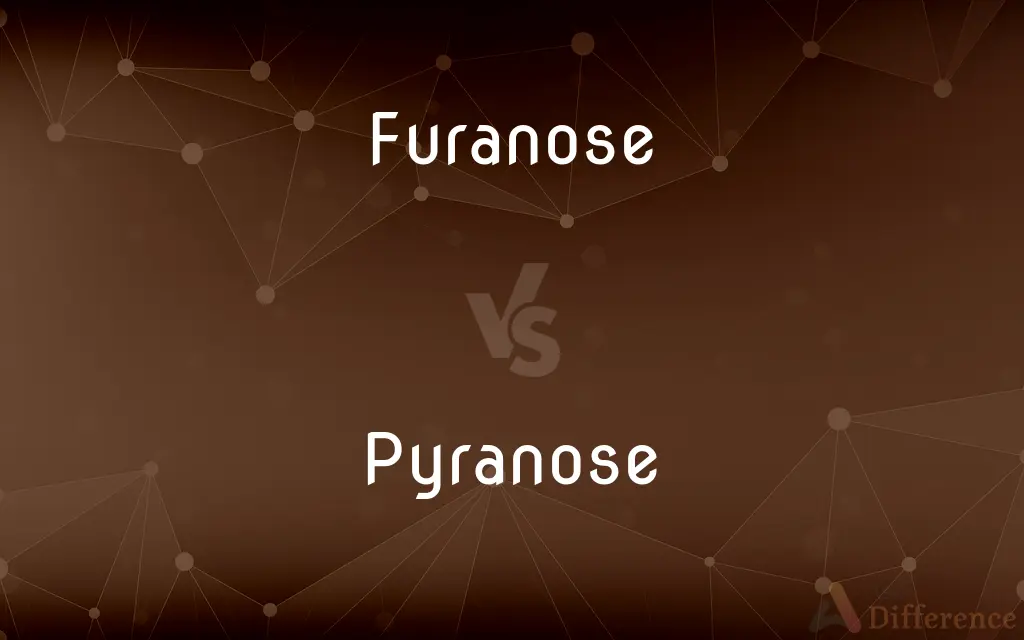Furanose vs. Pyranose — What's the Difference?
Edited by Tayyaba Rehman — By Fiza Rafique — Updated on October 5, 2023
Furanose and pyranose refer to five and six-membered ring forms of sugars, respectively, differing in ring size and atom composition.

Difference Between Furanose and Pyranose
Table of Contents
ADVERTISEMENT
Key Differences
Furanose forms are cyclic structures of monosaccharides that result from the intramolecular cyclization of the linear form of the sugar, forming a five-membered ring. Pyranose, on the other hand, is created through a similar process, but yields a six-membered ring instead. The furanose structure resembles the structure of furan, a heterocyclic compound containing an oxygen atom, while pyranose resembles pyran, which is a similar structure but with a six-membered ring.
When sugars cyclize, they form either furanose or pyranose structures, influenced by the configuration and the specific sugar involved. Furanoses have a tendency to be less stable compared to pyranoses due to the ring strain associated with the smaller, five-membered ring. Pyranose structures are often more prevalent for many sugars because the six-membered ring provides a more stable, less strained configuration.
The naming of furanose and pyranose comes from their similarity to the heterocyclic molecules, furan and pyran. Furan is a five-membered ring with four carbon atoms and one oxygen atom. Similarly, a furanose sugar ring has four carbon atoms, one oxygen atom, and is in a five-membered ring. In contrast, pyran is composed of five carbon atoms and one oxygen atom, forming a six-membered ring, paralleling the pyranose sugar configuration.
Furanose and pyranose structures are significant in biochemistry and organic chemistry, as they represent the forms of sugars that are actually encountered in biological systems. These cyclic structures exist in equilibrium with the linear form of the sugar in solution, with the cyclic form often predominating. Both furanose and pyranose structures exhibit anomeric carbon, resulting in alpha and beta anomers, which are stereoisomers differing in the configuration at the anomeric carbon.
Comparison Chart
Ring Size
Five-membered
Six-membered
ADVERTISEMENT
Example
Ribose, 2-deoxyribose
Glucose, Galactose
Stability
Generally less stable due to ring strain
Generally more stable
Common in
RNA (ribonucleic acid)
DNA (deoxyribonucleic acid)
Associated Molecule
Resembles Furan
Resembles Pyran
Compare with Definitions
Furanose
A carbohydrate derivative wherein the ring includes four carbons and one oxygen.
Deoxyribose, a furanose, is a crucial component of DNA.
Pyranose
A six-membered ring structure formed by cyclization of monosaccharides.
Glucose commonly exists in a pyranose form in many biological systems.
Furanose
A monosaccharide ring form featuring a five-membered structure.
Ribose, found in RNA, predominantly adopts a furanose form.
Pyranose
A carbohydrate derivative with a ring consisting of five carbons and one oxygen.
Galactopyranose is often found in milk sugars.
Furanose
The five-membered ring form of sugars, named for its resemblance to furan.
The furanose form can be depicted in Haworth projections.
Pyranose
The common cyclic structure of glucose, which can exhibit alpha or beta anomeric configurations.
The pyranose structure enables glucose to serve as an energy source in cellular processes.
Furanose
A less stable, cyclic form of sugars due to the structural strain of the five-membered ring.
Despite its lower stability, furanose is prevalent in various biochemical structures.
Pyranose
Significant in biochemistry, forming the structural basis for many polysaccharides.
Maltose is composed of two glucose pyranose units.
Furanose
A cyclic form of sugar, significant in biochemistry, especially in RNA structure.
Ribofuranose is an essential sugar in nucleic acids.
Pyranose
A stable cyclic form of sugar that resembles the structure of pyran.
Pyranose forms of sugars are typically represented in Haworth and chair conformations.
Furanose
A furanose is a collective term for carbohydrates that have a chemical structure that includes a five-membered ring system consisting of four carbon atoms and one oxygen atom. The name derives from its similarity to the oxygen heterocycle furan, but the furanose ring does not have double bonds.
Pyranose
Pyranose is a collective term for saccharides that have a chemical structure that includes a six-membered ring consisting of five carbon atoms and one oxygen atom. There may be other carbons external to the ring.
Furanose
A sugar having a cyclic structure resembling that of furan.
Pyranose
A compound whose molecule contains a saturated pyran ring, especially a sugar having this structure.
Furanose
(chemistry) any cyclic hemiacetal form of a monosaccharide having a five-membered ring (the tetrahydrofuran skeleton)
Pyranose
(chemistry) any cyclic hemiacetal form of a monosaccharide having a six-membered ring (based on tetrahydropyran)
Common Curiosities
What is furanose?
Furanose is a five-membered ring form of monosaccharides, resembling the structure of furan.
Which is generally more stable: furanose or pyranose?
Pyranose is generally more stable due to less ring strain compared to furanose.
Can a sugar molecule exist in both furanose and pyranose forms?
Yes, sugars can exist in equilibrium between furanose and pyranose forms, depending on conditions.
How is the naming of furanose and pyranose derived?
The names are derived from the heterocyclic compounds furan and pyran, which they resemble.
What is the significance of furanose in RNA?
Ribose, a furanose, forms the sugar-phosphate backbone in RNA molecules.
Do furanose and pyranose forms have functional differences in biological systems?
Yes, the ring form can influence the sugar's interactions and functions in biological molecules.
How does pyranose differ from furanose?
Pyranose forms a six-membered ring structure, whereas furanose forms a five-membered ring.
Why is the pyranose form prevalent in glucose?
The pyranose form of glucose is more stable and is therefore predominantly observed in nature.
What are examples of sugars in the pyranose form?
Glucose and galactose are common examples of sugars in the pyranose form.
Are furanose and pyranose structures stereoisomers?
Yes, they can be considered stereoisomers as they differ only in the spatial arrangement of atoms.
Are all monosaccharides capable of forming furanose and pyranose structures?
Not all, but many monosaccharides can cyclize to form either furanose or pyranose structures, depending on the sugar and conditions.
Which structure is common in DNA: furanose or pyranose?
Deoxyribose, a type of furanose, is a key component in the structure of DNA.
What is the main structural component of furanose?
Furanose has a five-membered ring, consisting of four carbon atoms and one oxygen atom.
What role does pyranose play in disaccharides?
Pyranose units can link via glycosidic bonds to form disaccharides, like maltose.
Can the furanose and pyranose forms interconvert?
Yes, they can interconvert through a process involving the opening and closing of the sugar ring.
Share Your Discovery

Previous Comparison
Marxism vs. Leninism
Next Comparison
Argument vs. PersuasionAuthor Spotlight
Written by
Fiza RafiqueFiza Rafique is a skilled content writer at AskDifference.com, where she meticulously refines and enhances written pieces. Drawing from her vast editorial expertise, Fiza ensures clarity, accuracy, and precision in every article. Passionate about language, she continually seeks to elevate the quality of content for readers worldwide.
Edited by
Tayyaba RehmanTayyaba Rehman is a distinguished writer, currently serving as a primary contributor to askdifference.com. As a researcher in semantics and etymology, Tayyaba's passion for the complexity of languages and their distinctions has found a perfect home on the platform. Tayyaba delves into the intricacies of language, distinguishing between commonly confused words and phrases, thereby providing clarity for readers worldwide.














































